Cats, with their enigmatic stares and mysterious habits, have long fascinated their human companions. Unlike dogs, whose behaviors and expressions are more straightforward, cats communicate through a nuanced blend of vocalizations, body language, and environmental interactions. Understanding your cat’s behavior can transform moments of confusion into opportunities for connection.
This article unveils five essential secrets to understanding your cat’s behavior. We’ll explore the deeper nuances of feline communication, from subtle tail flicks to the quiet but meaningful slow blink. By observing and learning from your cat, with patience and attention, you’ll enhance the mutual respect and affection in your relationship. Let’s embark on this journey together, unlocking the mysteries of cat behavior and enriching our lives with the sophisticated simplicity of our feline companions.
Table of Contents
Cat’s Behavior 1: The Language of Tails
One of the most expressive parts of a cat is its tail. Often overlooked, the tail acts like a mood barometer, providing insights into your cat’s emotional state. By paying close attention to tail movements and positions, you can gain a deeper understanding of your cat’s feelings and intentions.
The Tail High: Confidence and Contentment
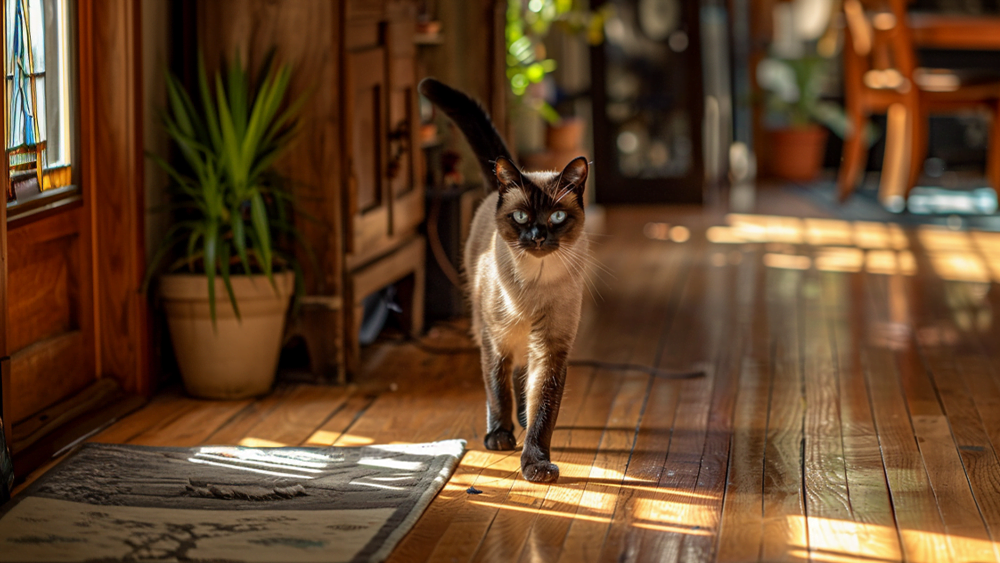
When a cat holds its tail high, it’s not just a matter of balance; it’s a clear sign of confidence and contentment. This posture can often be observed when your cat walks towards you or explores its environment. It’s their way of expressing happiness and a sense of security. A high tail also serves as an invitation for interaction, signaling that your cat is in a friendly mood and open to your company.
The Puffed Tail: Fear or Agitation
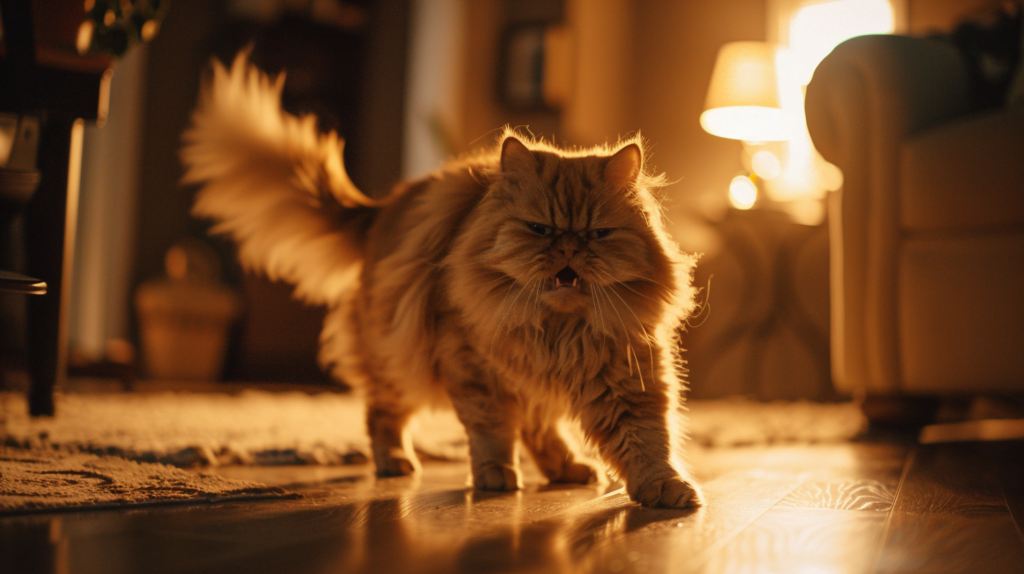
Conversely, a puffed-up tail indicates a heightened state of fear or agitation. This reaction is a part of the cat’s natural defense mechanism, intended to make them appear larger and more intimidating to potential threats. If you notice your cat’s tail bushing out along with an arched back, it’s best to give them some space. This behavior suggests they’re feeling threatened and need time to calm down.
The Question Mark Tail: Curiosity and Playfulness

A tail curved like a question mark is a fascinating display of curiosity and playfulness. When your cat approaches something with interest, its tail may form this distinctive shape, signaling a friendly disposition and a readiness to engage in play. This is a perfect time to interact with your cat, perhaps by offering a toy or initiating a game. Responding to these signals can significantly strengthen your bond and provide your cat with much-needed mental and physical stimulation.
Understanding the language of tails is just the beginning. As we continue to explore the secrets to cat behavior, remember that patience and observation are key. Each cat’s tail tells its own story, and learning to interpret these tales can transform your relationship with your feline friend.
Cat’s Behavior 2 – The Eyes Have It
The eyes of a cat are windows to their soul, revealing emotions and thoughts that words could never capture. Understanding the nuances of a cat’s gaze can significantly enhance the communication between you and your feline friend, allowing you to respond more empathetically to their needs and moods.
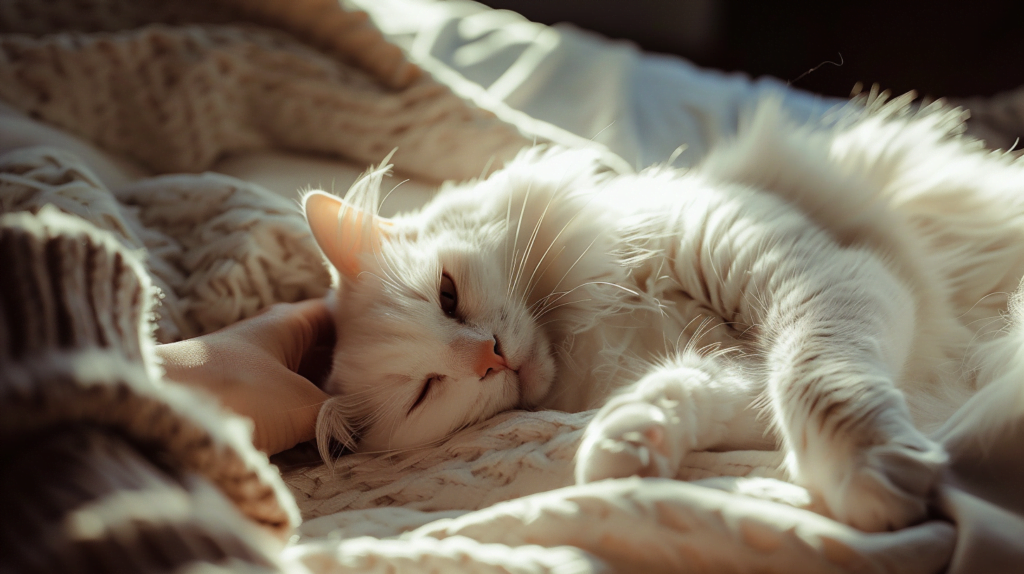
Slow Blinking: Trust and Affection
One of the most heartwarming interactions you can have with a cat is the slow blink. Often referred to as “kitty kisses,” this gesture is a sign of trust and affection. When your cat looks at you and blinks slowly, it’s their way of saying they feel safe and comfortable around you. You can return the gesture by slow-blinking back, which strengthens your bond and mutual affection.
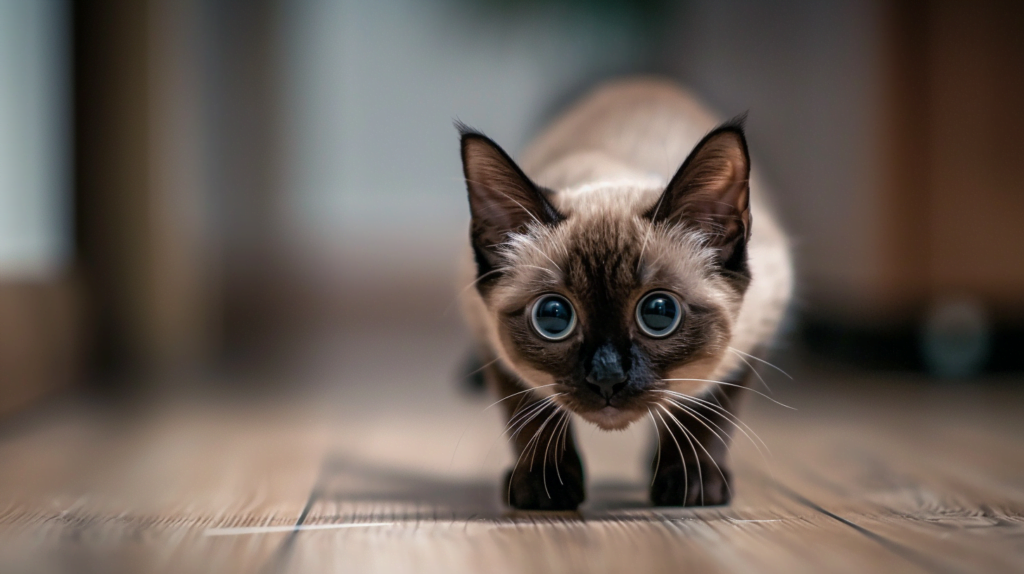
Dilated Pupils: Excitement or Agitation
A cat’s pupils can dilate dramatically in response to excitement, playfulness, or agitation. Wide-open pupils indicate heightened emotional states and should be read in the context of the cat’s environment and other body language. For example, dilated pupils during play signal excitement, but the same in a tense situation might indicate fear or aggression.
The Stare: Dominance or Aggression
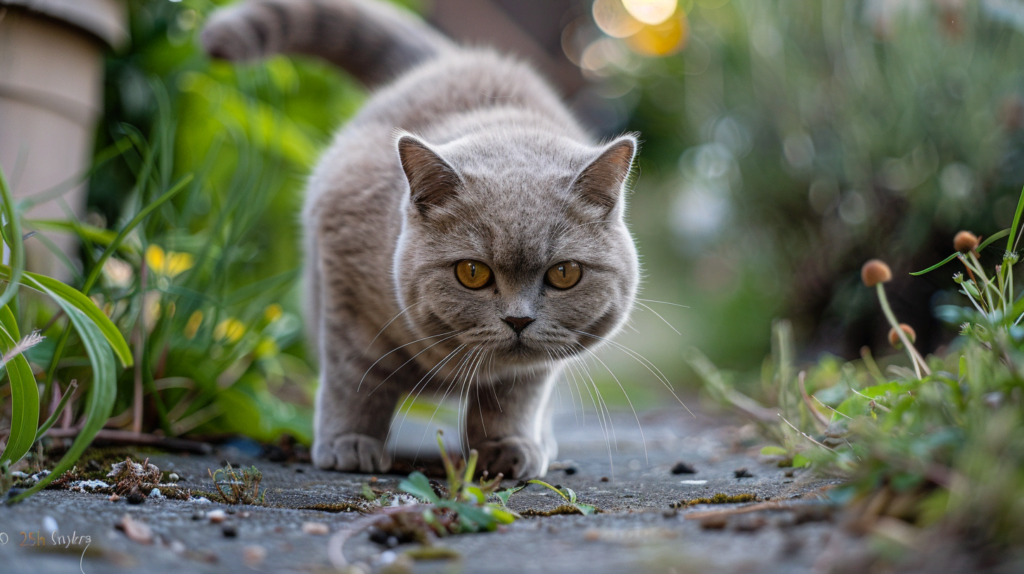
A direct stare from a cat, especially with dilated pupils and stiff body posture, can indicate dominance or aggression. In the wild, cats use staring as a way to assert dominance or intimidate rivals. If you’re on the receiving end of such a gaze, it’s best to slowly look away and give your cat some space, as direct eye contact can be perceived as a challenge.
By paying close attention to these eye signals, you can better understand and respond to your cat’s emotional state, ensuring a harmonious and respectful relationship.
Cat’s Behavior 3: Vocal Variations
The symphony of sounds a cat makes can convey everything from contentment to distress, making their vocalizations an essential aspect of their communication. Understanding these variations can deepen the bond between you and your cat, allowing for a richer mutual understanding.
Meowing: Communication with Humans
Contrary to popular belief, adult cats do not meow at each other but reserve this vocalization for their human companions. The meow can vary in tone, pitch, and duration, often indicating a range of desires or needs, from hunger or desire for attention to greeting or expressing concern. By tuning into the nuances of your cat’s meows, you can better meet their needs and strengthen your connection.
Purring: Contentment, or Sometimes Discomfort
Purring is perhaps the most well-known sound a cat makes, often associated with contentment and relaxation. However, cats also purr when they’re anxious, ill, or even when in pain, as purring may have a calming effect and even stimulate healing in their bodies. Observing the circumstances under which your cat purrs will help you understand their emotional state better.
Hissing and Growling: Fear, Anger, or Distress
Hissing and growling are unmistakable vocalizations that indicate a cat feels threatened, scared, or angry. These sounds are usually accompanied by defensive body language, such as an arched back, puffed tail, and flattened ears. Recognizing these signals as expressions of discomfort or fear can help prevent unwanted confrontations and reassure your cat.
By paying attention to these vocal cues, cat owners can navigate the complex emotional landscape of their feline friends, responding with empathy and understanding.
Cat’s Behavior 4: Kneading and Bunting
Cats express affection and comfort through a variety of physical behaviors. Two of the most endearing are kneading and bunting. These actions not only signify a cat’s affection towards their human companions but also their sense of safety and contentment.
Kneading: Comfort and Affection
Kneading, often referred to as “making biscuits,” is a behavior seen when cats push their paws in and out against a soft surface, such as a blanket or your lap. This action harks back to kittenhood when kneading stimulated milk flow from the mother. In adulthood, it’s a sign of contentment and affection, showing that your cat feels at ease and happy in your presence. If your cat kneads on you, it’s a sign of trust and love, considering you as much a part of their family as their feline mother.
Bunting: Marking Territory and Showing Love
Bunting is another affectionate behavior where a cat rubs their head, cheeks, or even their whole body against you. This action not only shows affection but also marks you with their scent, claiming you as “theirs.” Cats have scent glands in their cheeks that release pheromones when they bunt, which is a way of integrating you into their “colony.” If your cat bunts you, it’s a clear sign they consider you part of their trusted circle.
Understanding these signs of affection is crucial in building and maintaining a loving relationship with your cat. It’s their way of communicating comfort, love, and trust, reinforcing the special bond you share.
Cat’s Behavior 5: Understanding Play and Predatory Behavior
Cats, both domestic and wild, possess innate predatory instincts that play a vital role in their behavior. Understanding these instincts and how they manifest in play can greatly enhance the relationship between cats and their human companions.
The Importance of Play: Mental and Physical Health
Play is not just a leisure activity for cats; it’s an essential part of their daily routine that ensures their mental and physical well-being. Engaging in play mimics the predatory behaviors of hunting, stalking, and capturing prey, providing mental stimulation and physical exercise. Regular play sessions can help prevent boredom, reduce stress, and keep your cat physically fit. Toys that mimic the movement of prey, such as feather wands or laser pointers, can stimulate these natural instincts and provide fun and engaging activity for both you and your cat.
Predatory Instincts: Natural Behaviors and How to Safely Stimulate
While domestic cats don’t need to hunt for their meals, their predatory instincts remain strong. Understanding and safely stimulating these instincts can prevent unwanted behaviors, such as attacking feet or hands. Encouraging play with appropriate toys allows cats to express these natural behaviors in a safe and controlled environment, satisfying their hunting instincts without causing harm. Additionally, interactive play strengthens the bond between cats and their humans, fostering a deeper mutual understanding and respect.
Recognizing and respecting these innate behaviors is crucial in providing a fulfilling and enriching environment for your cat, ensuring they lead a happy and healthy life.
FAQ’s
Why does my cat put its tail up when it sees me?
When your cat puts its tail up upon seeing you, it’s expressing confidence and contentment. This high tail position is a friendly greeting, showing that your cat is happy and secure in your presence.
What does it mean when my cat blinks slowly at me?
Slow blinking from your cat is a sign of trust and affection, often referred to as “kitty kisses.” By slow blinking, your cat is saying they feel safe and comfortable around you. You can return the gesture to strengthen your bond.
Why do cats knead on soft surfaces or people?
Kneading, or “making biscuits,” is a comforting behavior cats carry from kittenhood. It’s associated with contentment and affection, indicating your cat feels at ease and happy with you.
My cat’s pupils are often dilated; should I be worried?
Dilated pupils can indicate excitement, playfulness, or agitation, depending on the context. Observe other body language and the environment to determine the cause. If dilation is constant and unprovoked, consulting a vet is advisable.
How can I tell if my cat is playing or feeling threatened?
Playful behavior usually involves relaxed body language and non-aggressive vocalizations. If your cat shows stiff posture, hisses, or growls, it may feel threatened. Recognizing these signs can help you respond appropriately.
What does it mean when a cat arches its back and puffs its tail?
An arched back and puffed tail are part of a cat’s natural defense mechanism, indicating fear or agitation. This posture makes them appear larger to ward off potential threats.
Why does my cat rub its head against me?
This behavior, known as bunting, is a way for cats to mark their territory and show affection. By rubbing their scent glands against you, they’re claiming you as part of their trusted circle.
How important is play for a cat’s well-being?
Play is crucial for a cat’s mental and physical health, mimicking predatory behaviors and providing necessary exercise. Regular play prevents boredom and stress, keeping your cat healthy.
Can purring indicate something other than happiness?
While often a sign of contentment, cats also purr when anxious, ill, or in pain, possibly due to purring’s calming effect and potential healing properties. Context is key to understanding this behavior.
What’s the best way to respond to my cat’s vocalizations?
Pay attention to the tone, pitch, and situation to interpret your cat’s needs. Responding empathetically to meows, purrs, and other sounds can deepen your understanding and strengthen your relationship.
Conclusion
Understanding your cat’s behavior is akin to learning a new language—a language that bridges the gap between species through love, respect, and companionship. We’ve journeyed through the nuanced communication of tails, the expressive power of eyes, the varied symphony of vocalizations, and the tender gestures of kneading and bunting. We’ve also explored the playful and predatory aspects of feline behavior, revealing how these natural instincts shape their interactions with us and their environment.
Observing and respecting these behaviors allows cat owners to forge a deeper, more meaningful connection with their feline companions. Recognizing signs of affection, understanding cues for play, and responding to their communication attempts not only enhances your cat’s well-being but also strengthens the bond you share. Patience and attentive observation are paramount. Each cat is unique, with its own personality and preferences. Embrace these differences, and let them guide your shared journey.
In the end, the key to understanding your cat lies in your willingness to listen, learn, and love. By tuning into their language and honoring their instincts, you unlock a world of mutual respect, affection, and endless companionship.

Leave a Reply
You must be logged in to post a comment.